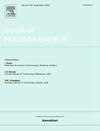基于CFD的热工水力参数和pH对蒸汽发生器腐蚀产物沉积的影响
IF 2.3
3区 工程技术
Q1 NUCLEAR SCIENCE & TECHNOLOGY
引用次数: 0
摘要
在压水堆一次回路中,腐蚀产物的沉积会对反应堆系统的性能产生不利影响,可能导致局部腐蚀。它们还会阻碍冷却剂的流动,或者在严重的情况下堵塞管道。此外,沉积物的导热系数低于结构材料,这可能会增加热阻,从而降低传热效率。尽管蒸汽发生器中存在大量的腐蚀产物,但对腐蚀产物沉积的研究仍然不足。采用热-液-化学过程三维综合模型,研究了蒸汽发生器腐蚀产物沉积的影响因素。为了确定传热管内沉积分布,根据计算得到的热工数据,根据等温差将管内划分为11个主节点。模拟结果表明,沉积厚度对冷却液温度、流速和pH值均有较大的敏感性,较高的温度(从560 K到600 K减少9.31%)、较高的pH(从6.5到8.0减少9.92%)和较低的流速(从5 m/s到20 m/s增加8.13%)可有效减少腐蚀产物的沉积,这是由于冷却液的物理化学性质和湍流的影响。而工作压力对其影响较小(从6 MPa增加到15 MPa,仅增加1.03%)。本文章由计算机程序翻译,如有差异,请以英文原文为准。
Effect of thermal-hydraulic parameters and pH on the corrosion product deposition in steam generator based on CFD
The deposition of corrosion products in the primary circuit of a pressurized water reactors is known to have an adverse impact on reactor system’s performance, which can cause localized corrosion. They can also impede the flow of coolant, or in severe cases block the tube channels. Besides, the deposits have a lower thermal conductivity than the structural materials, which may increase the thermal resistance, thus reducing heat transfer efficiency. Despite the presence of a considerable amount of corrosion products in steam generators, research on the deposition of corrosion products within is still insufficient. A comprehensive 3-D model of thermal–hydraulic and chemical processes was used to investigate the factors affecting the deposition of corrosion products in a steam generator. For the purpose of determine the deposition distribution along the heat transfer tube, the tube was separated into 11 main nodes based on the equal temperature differences according to the thermal–hydraulic data calculated. The simulation results indicate that the deposition thickness is sensitive to coolant temperature, flow velocity and pH value, and it was shown that higher temperature(from 560 K to 600 K decreasing 9.31 %), pH value (from 6.5 to 8.0 decreasing 9.92 %) and lower flow velocity (from 5 m/s to 20 m/s increasing 8.13 %)was effective for reducing the corrosion product deposition due to the physicochemical properties of the coolant and the turbulent flow, while working pressure has less influence on it(from 6 MPa to 15 MPa increasing only 1.03 %).
求助全文
通过发布文献求助,成功后即可免费获取论文全文。
去求助
来源期刊

Annals of Nuclear Energy
工程技术-核科学技术
CiteScore
4.30
自引率
21.10%
发文量
632
审稿时长
7.3 months
期刊介绍:
Annals of Nuclear Energy provides an international medium for the communication of original research, ideas and developments in all areas of the field of nuclear energy science and technology. Its scope embraces nuclear fuel reserves, fuel cycles and cost, materials, processing, system and component technology (fission only), design and optimization, direct conversion of nuclear energy sources, environmental control, reactor physics, heat transfer and fluid dynamics, structural analysis, fuel management, future developments, nuclear fuel and safety, nuclear aerosol, neutron physics, computer technology (both software and hardware), risk assessment, radioactive waste disposal and reactor thermal hydraulics. Papers submitted to Annals need to demonstrate a clear link to nuclear power generation/nuclear engineering. Papers which deal with pure nuclear physics, pure health physics, imaging, or attenuation and shielding properties of concretes and various geological materials are not within the scope of the journal. Also, papers that deal with policy or economics are not within the scope of the journal.
 求助内容:
求助内容: 应助结果提醒方式:
应助结果提醒方式:


